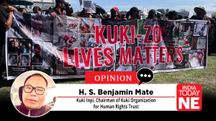Cookie Cutter approach will not work in Manipur: the complexity of Kuki ethnicity
The Kuki-Meitei conflict in Manipur has given rise to multiple narratives on ethnicity and religion, but one area that remains fairly unexplored in this discourse is that of the Kukis themselves.
 Cookie Cutter approach will not work in Manipur
Cookie Cutter approach will not work in ManipurThe Kuki-Meitei conflict in Manipur has given rise to multiple narratives on ethnicity and religion, but one area that remains fairly unexplored in this discourse is that of the Kukis themselves.
Ethnicity is a complex subject and this is true about multiple tribal groups in the North East, but perhaps more correct about Kuki. The term Kuki itself is fairly new. The earliest written reference to Kuki is 1777 from British records when tribesmen attacked British subjects in Chittagong. Neither the Burmese records nor Meitei Chronicles available from 33 AD have any reference to the term Kuki. It is believed that the term Kuki itself could be of Bengali origin to refer to hill people who undertook jhum cultivation.
Who is a Kuki?
Who is a Kuki or not a Kuki in Manipur is dynamic and continues to change even now. The 1931 census records two groups - Old Kuki and New Kuki. Anal, Kom, Hmar, Gangte and Vaiphei were part of the old Kuki group, while Paite, Ralte, Simte, Sukte and Thadou were classified as New Kuki.
Now, however, the Anal tribe identifies itself as Naga and not Kuki. Three erstwhile Kuki tribes Maring, Monsang and Moyon also call themselves Naga. As recently as 26th May 2023, the NSCN (IM) proclaimed Aimol, Chiru, Chothe, Kharam, Koireng and Kom from Manipur as part of the Naga Tribe.
Even the names of the sub-tribes are fluid. Paites call themselves Zomi in Myanmar, while in Mizoram they identify themselves as Mizos. In Manipur, they call themselves Paite.
The larger ethnic group has been also called by various names. Some use the term Zo people, others prefer to call it Chin-Kuki-Mizo (CKM). The total population of this group is said to be between 9 to 10 million and is spread across Mizoram, Manipur, Assam, Tripura, Nagaland, Meghalaya, Bangladesh and Myanmar. In Myanmar, Chins are recognised in its 1947 Constitution as among the four founding groups of the Union of Burma, along with Kachin, Shan and Burma. In India, the group has its own state- Mizoram.
In the Scheduled Tribe list of Meghalaya, Mizoram and Assam, 37 tribes are recognised as belonging to the term ‘Any Kuki Tribe”. Incidentally, under this umbrella of 37 Any Kuki tribe, there is a sub-tribe called Kuki.
In Manipur, things get a little curious. The state has a list of 34 tribes including two that are called ‘Any Mizo (Lushai) tribe’ and ‘Any Kuki tribe’. There has been steadfast opposition in Manipur to the inclusion of the term Kuki as a tribe. In a memorandum, submitted in July 2021, the Thadou apex Body, Thadou Inpi objected to the move of the State Government to recommend the addition of "Kuki" in the list of recognised Scheduled Tribes of Manipur. They said that Kuki is not a tribe, nor the name of a tribe, but a generic term to refer to a number of different tribes.
Thadou “hegemony”
Within Manipur, the Thadou form the largest group among all Kuki tribes. In fact, the Thadous form almost a quarter of the tribal population of Manipur, followed by the Tangkhul Nagas. The other recognised sub-tribes Paite, Zou, Gangte, Vaiphei, Hmar are much smaller. In fact, some of these smaller tribes prefer to call themselves Zo rather than Kuki.
There has always been an overhang of Thadou “hegemony” and “supremacy” over other Kuki tribes. The earliest book on Thadou is a 1928 book by Civil Services officer William Shaw. In the book, four great clans of Kukis are named as Lushei, Suhte, Poi and Thadou. According to the book, the Thadous “claim that the Changsan, Lhangum, Lenthang, Lunkim, Gangte, Waiphei, Kholhang, Chiru and those of inferior lineage were all under the wing of the Thadous and so they were included under that term.” Also, the use of terms in the past such as Kuki-Siki (Quarter Kuki) and Kuki-Makhai (Half Kuki) by Thadous to refer to the smaller tribes has alienated them.
Thadous have also historically dominated politics and bureaucracy. Outer Manipur, the tribal Lok Sabha constituency of Manipur has elected 17 Members of Parliament since 1952 and an overwhelming 14 of these MPs have been either Thadou or Tangkhul Naga. The Thadou tribe also had a disproportionate share in bureaucracy among the Kukis. The first ever person to ever qualify for the IAS from Manipur is neither a Meitei nor a Naga but a Thadou - K Kipgen in 1956. Similarly, the first tribal IPS officer from Manipur (1965) T Misao is a Thadou. Nengcha Lhouvum, one of the first women from the North East to become an ambassador (IFS 1980) is a Thadou. Manipur currently has two police officers at the DGP rank (P Doungel and C Doungel) - both are Thadou. Similarly, the senior most local IAS officer in Manipur - K Haokip, Additional Chief Secretary is a Thadou (the four senior-most bureaucrats ahead of Haokip in seniority are all from outside Manipur)
Thadous dominate the intellectual discourse as well. Many scholars quoted in media reports or writing in international publications on the current conflict like T Haokip from JNU, H. Sitlhou from the University of Hyderabad and M Sitlhou are all Thadou.
Thadou - Non-Thadou conflict
In Manipur, this has led to assertions by non-Thadou tribes and sometimes skirmishes that turn violent. The Kuki Naga conflict in Manipur between 1992 and 1997 that killed hundreds and displaced thousands is well known. What is not as well known is the Thadou- Paite clashes that also took the lives of hundreds of people and uprooted thousands of homes. These clashes took place in 1997-98 and the government had to send the army to control the damage. The aftermath of this conflict was the formation of the insurgent group Zomi Revolutionary army that comprised the minor tribes like Zou, Vaiphei, Gangte, and Simte led by the Paite. This is distinct from other insurgent groups like Kuki National Front/ Kuki National Army which is led by Thadous.
The Thadou apex body, Thadou Inpi has frequently clashed with Kuki Inpi on several occasions and has even declared that Kuki Inpi has no moral or legal authority to speak for and on behalf of the Thadous.
Even in the lead-up to the current tensions that led to the fateful rally on May 3rd in Churachandpur, there were differences between the groups. When Kuki Imti took out a protest rally against the Government’s eviction drive in the Kuki-dominated areas of Manipur on March 10th, 2023, the Thadou Imti was quick to disassociate itself from the rally.
Also stuck in this fight between the bigger communities are smaller tribes. Aimol tribe for example number less than 5,000 and they have asserted multiple times that Aimols are neither Kuki or Naga. Incidentally, Aimol is one of the tribes that the NSCN (IM) have recently declared as Naga.
The May 3rd incident seems to have united all Kuki/ Zo people across Manipur and in other states, however, the underlying faultlines cannot be just brushed away. Any long-term solution to the ongoing conflict in Manipur should not just involve the Meiteis and Thadou-led Kukis. It must also take into account the hopes, aspirations and identities of the smaller tribes of Manipur.
Copyright©2026 Living Media India Limited. For reprint rights: Syndications Today









